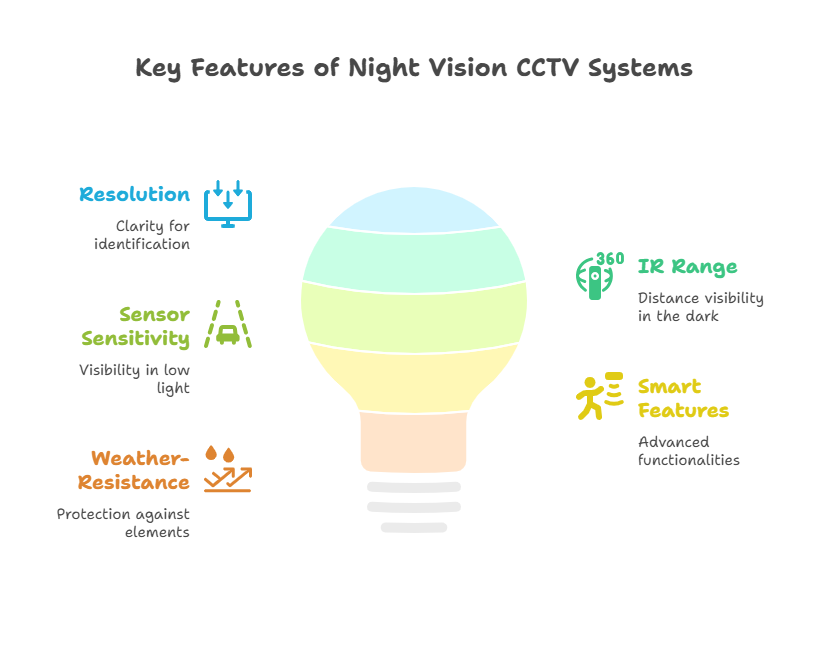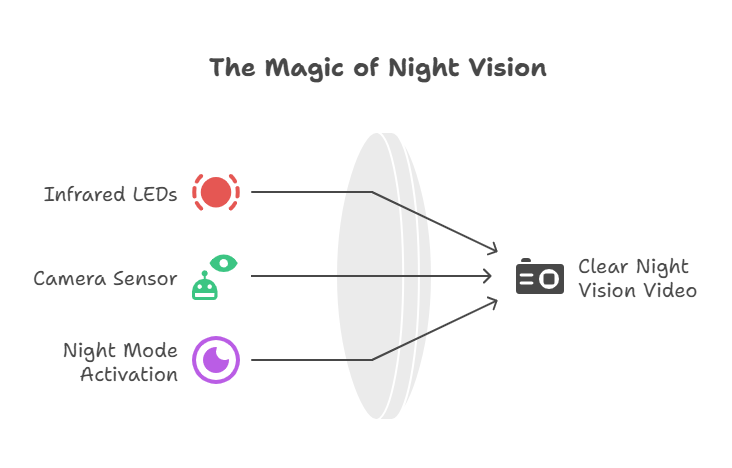When the sun goes down, your need for security doesn’t. In fact, for most homes and businesses, it’s after dark when surveillance matters most. But how exactly does a CCTV camera manage to “see” in the pitch black, when even our own eyes struggle to distinguish shadows from shapes? If you’ve ever asked yourself how CCTV cameras work at night, this blog will walk you through the fascinating technology behind modern night vision surveillance systems.
Having said that, one could be excused for thinking that magic is involved. After all, shooting footage in pitch black sounds way out of a spy thriller. But all the night vision CCTV means is a neatly designed array of technologies infrared light to thermal detection-that can watch animals or people in the shadows or with no light at all. Let us shed some invisible light on this darkness.
The Foundation: Night Vision and Why It Matters
Before diving into the nuts and bolts, it’s worth noting why night vision in CCTV is essential. Many security threats—whether break-ins, trespassing, or vandalism—happen under the cover of night. Standard cameras without night vision simply go blind once the lights go out. That’s where night vision steps in as your security system’s second set of eyes.
Advanced CCTV systems operate in the dark, providing 24-hour clear visuals using combinations of infrared illumination, advanced sensors, and, sometimes, heat detection. Alternatively, it does require some top military gear or superhero night goggles.
Infrared (IR) Illumination: The Invisible Light Source
The core of most night vision CCTV cameras is infrared illumination. These cameras come equipped with a ring of tiny IR LEDs surrounding the lens. These LEDs emit infrared light—completely invisible to the human eye—but perfectly detectable by the camera’s sensor.
The camera switches to night mode upon darkness and activates these LEDs. As the IR light bounces off the objects in the scene, the sensor picks up the reflections and converts them into a visible image. Result? A black-and-white video, far from an Oscar-winning cinematography, but clear enough to convey the action.
If you’ve ever seen a glowing set of eyes in animal photos at night, that’s IR light at work. Your camera does the same thing, only without the creepy cat stare.
IR Sensors and Cut Filters: The Brain and the Gatekeeper
The image sensor of the camera is in place to detect infrared light reflected off the human body. It uses either a CCD or a CMOS type of sensor. These types of sensors process the infrared light and convert it into electronic signals so that they may create an image on the screen.
But what about during the day? Enter the IR cut filter—a mechanical filter that blocks infrared light in daylight to ensure colors stay accurate. When night falls, the filter moves aside, letting IR light in for night mode. This seamless transition is what allows your CCTV to switch between day and night like a true multitasker.
Starlight Technology and Low-Light Enhancement
Now, what happens when there’s still a little bit of ambient light, say from a streetlamp or the moon? This is where starlight technology shines, literally and figuratively. Cameras equipped with starlight sensors amplify even the tiniest light sources to generate full-colour video in near-darkness.
It’s a brilliant middle ground between standard IR night vision and complete darkness. You get more detail, more clarity, and sometimes even a bit of colour. Think of it as giving your camera night glasses that work better than yours.
Thermal Imaging: Heat Over Light
For scenarios where there is no light—inside warehouses, in remote forests, or through heavy fog—some CCTV cameras turn to thermal imaging. These high-end models don’t rely on light at all. Instead, they detect heat signatures emitted by people, animals, or machinery.
By reading temperature differences, thermal cameras form a visual image of the scene. While these images are less detailed, they are unbeatable when visibility is truly zero. And yes, they can see a warm body in a cold room—no flashlight required.
So… How CCTV Camera Works at Night?
By now, you’ve probably got a good sense of how CCTV camera works at night. It’s not just one feature—it’s an elegant combination of technologies working in harmony.
First, infrared LEDs light up the scene invisibly. Then, CMOS or CCD sensors detect the reflected light. The IR cut filter helps switch modes, while starlight sensors amplify minimal ambient light. For tougher environments, thermal imaging adds another dimension.
Whether you’re monitoring a driveway, a warehouse, or your backyard chicken coop (yes, we’ve seen it all), these tools ensure you’re not left in the dark—literally.
Beyond Vision: Smart Features That Matter at Night
A present-day closed-circuit television system does not merely investigate darkness. It is endowed with motion detection, real-time alerting mechanisms, and smart spotlights that flash with any motion-triggering activity. These provide extra layers of responsiveness and intelligence, refashioning your camera into a security partner that almost counterposes the passiveness of observation.
Motion detection can trigger alerts to your phone, start recording automatically, or even flash a deterrent spotlight. That’s night surveillance with attitude.

What to Look for in a Night Vision CCTV Camera
Choosing the right night vision CCTV system isn’t just about IR LEDs. You’ll want to look at:
- Resolution: A common resolution to start with is 1080p; however, 2K or 4K designs offer better clarity for identification.
- IR Range: Selecting a camera means choosing something that can see in the dark from afar; 50 to 100 feet is a suggested marker in the outdoors.
- Sensor Sensitivity: Low-lux or starlight sensors improve the visibility provided in very little light.
- Smart Features: Motion detection, remote viewing, and mobile alerts would be highly desirable with current uses.
- Weather-Resistance: Any camera to be used outdoors needs to boast an IP65 rating or better.
Seeing is Believing—Even at Night
If you happen to be checking your security feed at 2 AM and get the clearest possible view of your porch, a little knowledge about why it is so clear will make the whole exercise interesting. Appreciating how a camera works under darkness will appreciate the technology and empower you to make better decisions when buying surveillance systems.
Whether it’s infrared illumination, starlight enhancement, or thermal imaging, night vision transforms your CCTV system from a daytime tool into a 24/7 guardian.
How CCTV Camera Shop Chandigarh Can Help
If you want your night vision-enabled outdoor security systems installed by professionals, call CCTV Camera Shop in Chandigarh. With over 35 years of experience in security technology, watch as we walk you through all the choices of cameras, which may include long-range IR, full-colour night vision, and smart motion alerts.
Ready to light up the night? Contact us today for a free consultation and discover the perfect night vision CCTV system for your needs.

